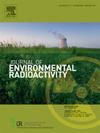The Indian Network for Detecting Radon Anomaly signal for Seismic Application
IF 2.1
3区 环境科学与生态学
Q3 ENVIRONMENTAL SCIENCES
引用次数: 0
Abstract
The Indian Network for Detecting Radon Anomaly Signal for Seismic Application (INDRA-SA) has been established to investigate ground radon exhalation as a potential earthquake precursor in the Indian subcontinent. As part of this initiative, up to 100 BhaROSA (Bhabha Radon Observatory for Seismic Application) systems have been deployed near active fault lines across the Indian Tectonic Plate. Each self-sustaining, solar-powered BhaROSA unit is equipped with a radon accumulator, a continuous radon monitor, environmental shielding, battery backup, and secure data transmission via 3G/4G GPRS on a Virtual Private Network. Site selection focused on regions with significant seismicity, particularly the Himalayan fault system and faults in the Eastern and Western Ghats. Data from each station is transmitted every 15 min to a central server, which also integrates earthquake event data from national and international agencies. At the central station, post-processing filters out meteorological noise (e.g., diurnal cycles, rainfall, low pressure) to isolate potential precursory radon anomalies. Analysis of data from notable earthquakes in the study region revealed persistent radon anomalies occurring days to months before major events. Rare radon signals preceding rare seismic events in low-activity zones further support a strong correlation. The INDRA network provides valuable insights into the spatial and temporal responses of radon signal prior and post seismic events to enhance our understanding of the complex processes involved in earthquake nucleation along fault lines. This initiative is a significant step towards advancing earthquake predictability— a longstanding and unresolved challenge for humanity.
印度地震用氡异常信号探测网
印度地震应用氡异常信号探测网络(INDRA-SA)已经建立,目的是调查地面氡呼出作为印度次大陆潜在地震前兆的情况。作为该计划的一部分,多达100个BhaROSA (Bhabha氡地震应用观测站)系统已部署在印度构造板块的活动断层线附近。每个自给自足的太阳能供电的BhaROSA装置都配备了一个氡蓄能器、一个连续的氡监测仪、环境屏蔽、备用电池,并通过虚拟专用网络上的3G/4G GPRS进行安全数据传输。选址主要集中在地震活动性强的地区,特别是喜马拉雅断层系统和东西高止山脉的断层。每个台站的数据每15分钟传送一次到中央服务器,中央服务器还整合了来自国家和国际机构的地震事件数据。在中央站,后处理滤除气象噪声(例如,日周期、降雨、低压),以隔离潜在的前兆氡异常。对研究地区的重大地震数据的分析显示,在重大地震发生前几天到几个月,氡气持续异常。在低活跃区,罕见地震事件发生前的罕见氡信号进一步支持了强相关性。INDRA网络对地震前后氡信号的时空响应提供了有价值的见解,以增强我们对断层线地震成核的复杂过程的理解。这项倡议是朝着提高地震可预见性迈出的重要一步——地震可预见性是人类面临的一个长期未解决的挑战。
本文章由计算机程序翻译,如有差异,请以英文原文为准。
求助全文
约1分钟内获得全文
求助全文
来源期刊

Journal of environmental radioactivity
环境科学-环境科学
CiteScore
4.70
自引率
13.00%
发文量
209
审稿时长
73 days
期刊介绍:
The Journal of Environmental Radioactivity provides a coherent international forum for publication of original research or review papers on any aspect of the occurrence of radioactivity in natural systems.
Relevant subject areas range from applications of environmental radionuclides as mechanistic or timescale tracers of natural processes to assessments of the radioecological or radiological effects of ambient radioactivity. Papers deal with naturally occurring nuclides or with those created and released by man through nuclear weapons manufacture and testing, energy production, fuel-cycle technology, etc. Reports on radioactivity in the oceans, sediments, rivers, lakes, groundwaters, soils, atmosphere and all divisions of the biosphere are welcomed, but these should not simply be of a monitoring nature unless the data are particularly innovative.
 求助内容:
求助内容: 应助结果提醒方式:
应助结果提醒方式:


